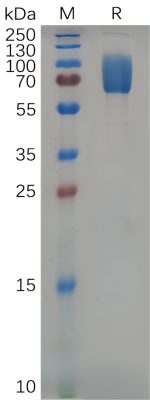| Target | |
|---|---|
| Synonyms |
2B4;C9.1;F730046O15Rik;Ly90;NAIL;NKR2B4;Nmrk;SLAMF4 |
| Description |
Recombinant mouse 2B4 protein with C-terminal human Fc tag |
| Delivery |
In Stock |
| Uniprot ID |
Q07763 |
| Expression Host |
HEK293 |
| Tag |
C-Human Fc Tag |
| Molecular Characterization |
Mouse 2B4(Gln20-Leu225) hFc(Glu99-Ala330) |
| Molecular Weight |
The protein has a predicted molecular mass of 49.4 kDa after removal of the signal peptide.The apparent molecular mass of m2B4-hFc is approximately 55-100 kDa due to glycosylation. |
| Purity |
The purity of the protein is greater than 95% as determined by SDS-PAGE and Coomassie blue staining. |
| Formulation & Reconstitution |
Lyophilized from sterile PBS, pH 7.4. Normally 5 % – 8% trehalose is added as protectants before lyophilization. Please see Certificate of Analysis for specific instructions of reconstitution. |
| Storage & Shipping |
Store at -20°C to -80°C for 12 months in lyophilized form. After reconstitution, if not intended for use within a month, aliquot and store at -80°C (Avoid repeated freezing and thawing). Lyophilized proteins are shipped at ambient temperature. |
| Background |
Heterophilic receptor of the signaling lymphocytic activation molecule (SLAM) family; its ligand is CD48. SLAM receptors triggered by homo- or heterotypic cell-cell interactions are modulating the activation and differentiation of a wide variety of immune cells and thus are involved in the regulation and interconnection of both innate and adaptive immune response. Activities are controlled by presence or absence of small cytoplasmic adapter proteins, SH2D1A/SAP and/or SH2D1B/EAT-2. Acts as activating natural killer (NK) cell receptor (PubMed:8326140, PubMed:12734329, PubMed:19648922, PubMed:20962259). Activating function implicates association with SH2D1A and FYN. Downstreaming signaling involves predominantly VAV1, and, to a lesser degree, INPP5D/SHIP1 and CBL. Signal attenuation in the absence of SH2D1A is proposed to be dependent on INPP5D and to a lesser extent PTPN6/SHP-1 and PTPN11/SHP-2. Stimulates NK cell cytotoxicity, production of IFN-gamma and granule exocytosis (PubMed:8326140, PubMed:15169881, PubMed:15998796, PubMed:22683124). Optimal expansion and activation of NK cells seems to be dependent on the engagement of CD244 with CD48 expressed on neighboring NK cells (PubMed:15905190). Regulation of NK cell activity by adapters Sh2d1b and Sh2d1b2 is reported conflictingly (PubMed:16127454, PubMed:16425036). Acts as costimulator in NK activation by enhancing signals by other NK receptors such as NCR3 and NCR1. At early stages of NK cell differentiation may function as an inhibitory receptor possibly ensuring the self-tolerance of developing NK cells (By similarity). Involved in the regulation of CD8( ) T-cell proliferation; expression on activated T-cells and binding to CD488 provides costimulatory-like function for neighboring T-cells (PubMed:11739483). Inhibits inflammatory responses in dendritic cells (DCs) (PubMed:25643613).[UniProtKB/Swiss-Prot Function] |
| Usage |
Research use only |
1
/
의
1
Dima Biotech
SKU(재고 관리 코드):PME-M100004
Mouse 2B4 Protein, hFc Tag
Mouse 2B4 Protein, hFc Tag
PRODUCT DATA
IMAGES

Figure 1. Mouse 2B4 Protein, hFc Tag on SDS-PAGE under reducing condition.
Share


